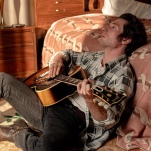Summer Brennan Reveals the Complex, Violent History of an Iconic Object in High Heel
Photo of the Ruby Slippers from The Wizard of Oz by Astrid Stawiarz / Stringer
When I was very young, my parents surprised me with a pair of ruby red slippers.
The Wizard of Oz was one of my favorite films, and Dorothy’s adventure was the exact kind of story in which I wanted to take part. So on Easter morning, my parents placed a pair of glittery red flats in a ray of sunshine streaming into our playroom; when I opened the door, the shoes were shimmering in the middle of the floor. It’s the first pair of shoes I remember receiving, and it’s the first time I remember viewing a pair of high heels as something that could reinvent me.
Myths about the transformative power of high heels are central to Summer Brennan’s latest book, High Heel. Part of Bloomsbury’s Object Lessons series, the book traces the history and cultural associations of high heels, primarily as worn by women. Drawing from Ovid’s tales to Cinderella to witch trials to modern courtrooms, Brennan makes the case that high heels are an apt metaphor for the ways in which women have been hobbled in their mobility. She also tackles the relationship between beauty and suffering, highlighting the fraught nature of reclaiming objects defined under patriarchy for feminism.
What many of the stories in High Heel share is a woman’s suffering and mutilation. Brennan recounts the ways in which fairy tales fixated on shoes in their original, more grotesque versions, explaining how often women and girls were subjected to effective torture because of their footwear. Cinderella’s prideful stepsisters mutilate their own feet in order to unsuccessfully woo a prince; the Little Mermaid’s chooses to walk despite every step feeling like she’s cut by knives; Karen, of “The Red Shoes,” has her feet amputated to remove the shoes that force her to incessantly dance.
 Extreme as we may consider these fictions, reality is often no less bizarre. Brennan writes about the history of foot binding, the ways in which high heels and witchcraft were conflated in colonial America, and a U.K. rapist who took high heels as trophies from possibly over 100 female victims. There is also the damage high heels, particularly stilettos, do to the human foot after prolonged wear; Sarah Jessica Parker, who played the famously high-heeled Carrie Bradshaw on Sex and the City, has spoken about the deforming impact of the footwear that defined her style in the public eye.
Extreme as we may consider these fictions, reality is often no less bizarre. Brennan writes about the history of foot binding, the ways in which high heels and witchcraft were conflated in colonial America, and a U.K. rapist who took high heels as trophies from possibly over 100 female victims. There is also the damage high heels, particularly stilettos, do to the human foot after prolonged wear; Sarah Jessica Parker, who played the famously high-heeled Carrie Bradshaw on Sex and the City, has spoken about the deforming impact of the footwear that defined her style in the public eye.
Sarah Jessica Parker’s case reveals how violence manifests in beauty. The physical transformation promised by high heels—the flexing of muscle, the lengthening of leg, the alteration of gait—is achievable because one is willing to inflict a level of pain upon oneself. The sex appeal of heels is also rooted in the ability to look past that violence and only value the aesthetic they create.
High heels once openly signified the wearer’s capacity for violent conquest; Brennan writes that French nobility wore red high heels as a representation of their ability to defeat the enemies of the king. In her hit song “Bodak Yellow,” Cardi B calls to mind a similar marriage of fashion and threat when she talks about her Christian Louboutin shoes as having “red bottoms / these is bloody shoes.” There’s power in a high heel, a power that women have not always been able to claim.
The conversation becomes more complex when—as Brennan does intermittently throughout the book—taking into account what heels mean when worn by transgender women, non-binary individuals or cis-men. More than any other shoes, heels are coded as female. As such, they can be freeing for those who want to present as female or feminine.
But even this freedom doesn’t change the way heels physically hobble the wearer. What makes us professional, sexy and transformed also takes away our basic ability to move through the world without worry. This is both in the sense of our own ability to walk and in the sense of potential threats to our safety; if we consider the ways in which we are taught that the world is full of predators, then high heels are a method by which we become more easily caught prey.
There is something perverse in the way that beauty choices—be it shoes or makeup or clothes—become a stand-in for the weapons of patriarchy, shutting down nuanced debate in favor of finding a way to make no woman feel she’s made the right choice. As Brennan notes, “What confines, impoverishes, exploits, enslaves, oppresses, sickens, bloodies, rapes, and kills women are not generally clothes or shoes, but rather laws and societal norms.”
And yet we cannot deny the appeal of high heels, even tangled in their messy legacy. To do so would be to ignore the fact that many people choose to wear heels for fun. As with all methods of achieving traditionally femme beauty standards, even when you see the problematic shade of something, sometimes you just want to feel like your most gorgeous self.
When I was very young, I loved a story about a girl whose shoes were an intrinsic part of her adventure. I didn’t know then that, as Brennan writes, the actress I saw on screen was suffering through a starvation diet and a cocktail of pills that would lead to an addiction that killed her by age 50. I didn’t grow up on tales in which shoes were accessories to or responsible for destruction in that way. Instead, I grew up on stories about independent women taking urban landscapes by storm in sky-high heels, and I wanted to be one of them.
I suppose part of me might still want to be one of them; I pinch my toes into heels on rare occasions and feel beautiful, even as I feel blisters swelling. At the end of the night, I take them off and enjoy that brief transitional period of feeling my feet adjust to being fully planted on the ground.
High heels—despite all their baggage—cast a spell, one that is a pleasure to feel slip away.
Bridey Heing is a freelance writer based in Washington, DC. More of her work can be found here.







































